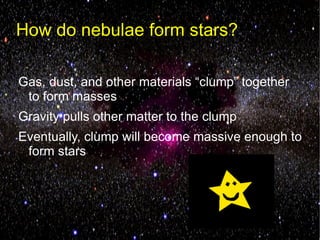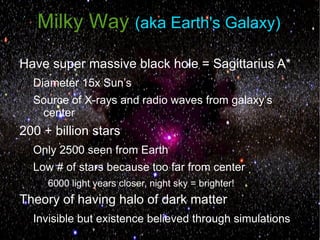Nebulae & Galaxies
- 1. Nebulae & Galaxies B y : J a s m i n e Ta m , J e n n if e r L e e , &
- 2. What is a nebula? A nebula is an interstellar cloud of dust, hydrogen, helium and other ionized gases
- 3. How do nebulae form stars? Gas, dust, and other materials “clump” together to form masses Gravity pulls other matter to the clump Eventually, clump will become massive enough to form stars
- 4. How are nebulae formed? Collapse of interstellar gas in space Ultraviolet rays from surrounding stars ionizes the surrounding gas making the nebula visible Supernova explosions from stars of over 100 solar masses When stars lose their outer layers of gases at the end of their lives
- 5. Types of Nebula: Diffuse Nebula Supernova Remnant Emission Reflection Dark Nebula Nebula Nebula Planetary H II Regions Nebula
- 6. Diffuse Nebula: Nebulae which are extended and do not contain (visible) well-defined boundaries Some diffuse nebula contain enough gas and dust to form about 100,000 stars the size of the sun May be positioned near a bright star
- 7. Diffuse Nebula – Emission Nebula Light from a nearby star energizes the gas atoms of the nebula causing this nebula to be able to emit light There are 2 types of emission nebulae Planetary Nebula H II Regions
- 8. Diffuse Nebula – Emission Nebula Planetary Nebula H II Regions Occurs during red giant Newly formed stars emit phase of a star when ultraviolet light which outer layers of star is ionize the surrounding shed gases Ultraviolet radiation from exposed core ionizes shed layers Ring Nebula “Pillars of Creation” Eagle Nebula
- 9. Diffuse Nebula – Reflection Nebula Do NOT emit light Dust particles reflect light from stars Usually blue in colour because dust grains Witch Head Trifid Nebula reflect more blue light than red light Nebula
- 10. Supernova Remnant Caused by the explosion of a star Consists of the ejected matter from the explosion Crab Nebula
- 11. Dark Nebula
- 12. Dark Nebula – What is it? Interstellar cloud that is extremely dense with interstellar dust grains located in the coldest, darkest places of the nebula. It is dark enough to block out ALL light! Even the neighbouring stars around the nebula!
- 13. Coal Sack Nebula Brilliant example of a dark nebula, as it can easily be seen by human eyes. On bright, starry nights, it’s seen as a dark patch on the night sky, clearly apparent from the background of Milky Way Belongs to the constellation Crux, and can only be seen in the Southern Hemisphere
- 14. Snake Nebula Dark Nebulae have no definite shape and boundaries Many twist and turn into convulsing shapes. A good example is the Snake Nebula Also known as Barnard 72, it is S-shaped and found in the constellation Ophiuchus Part of the Great Dark Horse Nebula
- 15. Horse Head Nebula Perhaps the most famous of the Dark Nebulae, also known as Barnard 33, is the Horse Head Nebula. Found in constellation Orion, and it lies behind the star Alnitak. Categorized and found by Edward Emerson About 1600 light years away More apparent because the bright nebula, IC 434 is behind it, casting a larger shadow.
- 16. Bok Globules and New Stars Small dark nebulae are often referred to as Bok Globules. Cool clouds of gas and dust that are more spherical in shape, resembling drops of water Named after Bart J. Bok (American astronomer) Believed to create lower mass stars. Dark Nebulae also site for creating new stars, as mentioned by Jen.
- 17. Planetary Nebula
- 18. What are they? Type of emission nebulae Cloud of ionized gas that emit light in various colors Lit up by a central star Looks like small planets through optical telescopes, which is why they are called PLANETary nebulae Formed when a star is dying (in red giant stage) Outside layer of star dissipates and star shines brighter and hotter with out outer layer Can reach up to 25 000 to 200 000 degrees celsius Ultraviolet radiation from the core of the star ionizes the gas and plasma which creates the colorful lights
- 19. General Help create new stars Info : Star dies => metals in core sent across universe => metal able to create new stars Only stars that are around the same mass of our sun (1 solar mass) can turn into a planetary nebula 8 solar masses or more will turn into a supernova instead Generally found in the plane of the Milky Way, but are more closely gathered in the centre of Milky Way Not very bright compared to other nebulae, even thought their central star are some of the hottest known in the universe Because the hotter a star is, the more ultraviolet rays make it hard to see it in visible light
- 20. Bug Nebula Found in constellation Scorpius Outer structure (bipolar planetary nebula) considered to be the most complex of all known planetary nebulae. Central star also considered to be hottest in the galaxy, but very faint to see on Earth -white dwarf that burns at 200 000 K
- 21. Cat's Eye Nebula Found in constellation Draco (3300 light years away) Also contains highly complicated structure that contains a hot central star that lost it’s outer layer over 1000 years ago Found by William Herschel Shells that appear in the photo are actually layers of ionized gas from the dying star
- 23. So What Happens When a Star Explodes? As mentioned before, if the star was less than 8 solar masses, it will turn into a planetary nebulae If more than 8 solar masses, it will turn into a supernova remnant! Supernova remnant is the structure left behind after a supernova explosion (star goes BOOM) Heats up interstellar medium and sends out important metals throughout universe
- 24. Types of Supernova Remnants (I) 2 main types: First type is the shell-type remnant (heats up interstellar medium during explosion) Interstellar medium: dust and gas between stars and galaxies (after supernova explosion becomes hot) Cygnus Loop: example of a shell type remnant (show picture) Found in constellation Cygnus (extremely large for a supernova remnant) Scientists have found 4 smaller nebulae inside the Loop!
- 25. Types of Supernova Remnants (II) Crab Nebula Second type is crab-type found in Famous Crab Nebula remnant. (also called pulsar wind (show constellation Taurus nebulae) picture) Contains neutron star that sends out regular pulses of radiation Crab Central neutron star called Pulsar These supernova remnants filled with high energy electrons from the neutron Spins 30.2 times per second starwhile emitting radiation
- 26. Galaxies
- 27. What are Spiral Galaxies? Thin structures similar to a disk Have arms of stars spiralled around the galaxy’s center. Tightly wound spiral called “Sa” ; loose spiral is called “Sc.” Consist of mainly young, new stars Have interstellar matter in galaxy disk approximately 10,000 to almost 100,000 light years in diameter
- 28. What are Spiral Galaxies? Center of the spiral galaxy bulge (a dense concentration of stars) Diameter of a few thousand light years Extends above and below the disk. Spiral arms & blue waves in the galaxy disk’s density hold high proportion of huge, hot stars Stars shine longer & have brighter light than smaller, more common stars, eg. Sun
- 30. What are Barred-Spiral (SB) Galaxies? Very similar to spiral galaxies Have a bar of stars running through the middle Tightly wound barred-spiral galaxy is called “SBa” ; loosely wound barred-spiral galaxy Called “SBc.”
- 31. What are Barred-Spiral (SB) Galaxies? Theories of bar fueling stars during its evolution. Theories of bar created by density wave from the galaxy’s center Caused the inner stars to reshape its orbit. Those stars orbit further out T the structure of bar
- 33. Milky Way (aka Earth's Galaxy) Part of the Local Group which contains over 24 other galaxies Contains many beautiful and important features Nebula in Orion’s sword. Birthing ground where powerful stars produced. Created from swallowing other galaxies Stars from the Sagittarius Dwarf Galaxy As old as the universe Milky Way: 13.6 billion yrs ; universe 13. 7 billion yrs. Galaxy’s disk and the bulge not created until 10-12 billion yrs ago
- 34. Milky Way (aka Earth's Galaxy) Has halo of approximately 150 globular clusters scattered around galactic center Globular clusters = thousands of millions of old stars tightly grouped together Only 20-30 light years across = concentrated in a swarm Stars so old most less than two solar masses & glow yellow- red. Dusty and gassy Only allow to see 6000 light years in visible spectrum Deflects visible light Infrared light can still pass through Use infrared telescope (Spitzer Space Telescope) and clearly see galaxy’s center and regions where stars form
- 35. Milky Way (aka Earth's Galaxy) Have super massive black hole = Sagittarius A* Diameter 15x Sun’s Source of X-rays and radio waves from galaxy’s center 200 + billion stars Only 2500 seen from Earth Low # of stars because too far from center 6000 light years closer, night sky = brighter! Theory of having halo of dark matter Invisible but existence believed through simulations
- 37. The End (:




































